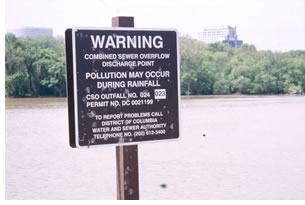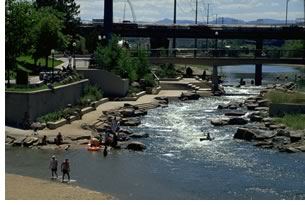

07/2004
APA Offers New Report on Riverfront Design
 “As
cities reclaim their rivers, a rare opportunity is offered to repair past
damage, to prevent new injury, and to create more sustainable communities,”
conclude the authors of Ecological Riverfront
Design, a new report presented by the American Planning Association
(APA) and American Rivers. The report estimates that $500 million will
be spent on riverfront revitalization in the first half of this decade.
“To take advantage of this opportunity, we need to effectively integrate
ecological considerations with economic and social goals along the nation’s
urban rivers. [This report] promotes the view that we can achieve much
greater environmental as well as social and economic success if urban
riverfronts are designed with ecological principles in mind.”
“As
cities reclaim their rivers, a rare opportunity is offered to repair past
damage, to prevent new injury, and to create more sustainable communities,”
conclude the authors of Ecological Riverfront
Design, a new report presented by the American Planning Association
(APA) and American Rivers. The report estimates that $500 million will
be spent on riverfront revitalization in the first half of this decade.
“To take advantage of this opportunity, we need to effectively integrate
ecological considerations with economic and social goals along the nation’s
urban rivers. [This report] promotes the view that we can achieve much
greater environmental as well as social and economic success if urban
riverfronts are designed with ecological principles in mind.”
 Profiles
and principles
Profiles
and principles
Ecological Riverfront Design offers
help to architects, planners, mayors, developers, investors, government
officials, river advocates, and others who are planning or evaluating
riverfront development efforts. The report pulls its lessons from more
than 30 revitalization efforts across the country, including in-depth
profiles of the Chicago River and Portland, Ore.’s Willamette River.
Other case studies include Detroit’s Rouge River, New York City’s
Bronx River, the Los Angeles River, and Chattanooga’s Tennessee
River.
According to Betsy Otto, lead author of the report, “It makes good business sense for communities and developers to restore the river while rehabilitating properties along the bank. People spend time and money in attractive environments that emphasize natural beauty and wildlife.” The report presents a comprehensive set of recommendations for integrating pollution prevention and habitat improvements into riverfront redevelopment efforts. Design principles include:
- Buffering sensitive natural areas
- Using nonstructural alternatives to manage water resources
- Balancing recreational and public access goals with river protection
- Managing stormwater on site
- Reducing hardscapes.
 Eternal
vigilance
Eternal
vigilance
Although today’s urban rivers are considerably cleaner than they
were 30 years ago, the Environmental Protection Agency warns that reduced
enforcement of clean water laws and decreased sewage infrastructure investment
could cause our rivers to return to 1970s sewage and odor levels by 2016.
“Revitalization efforts won’t be successful if we don’t
safeguard the water quality improvements that drew people back to their
rivers in the first place,” Otto said. “Communities can help
ensure success by reminding their state and federal representatives about
their aspirations for an attractive, inviting river.”
Copies of Ecological Riverfront Design may be obtained through the APA Web site.
Copyright 2004 The American Institute of Architects.
All rights reserved. Home Page ![]()
![]()
 |
||
|
||